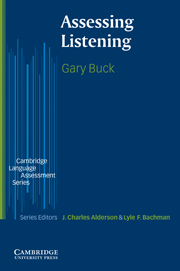Book contents
- Frontmatter
- Contents
- Series Editors' Preface
- Acknowledgements
- 1 An overview of listening comprehension
- 2 What is unique to listening
- 3 Approaches to assessing listening
- 4 Defining the construct
- 5 Creating tasks
- 6 Providing suitable texts
- 7 Designing and constructing complete assessments
- 8 Illustrative tests of listening comprehension
- 9 Summary and future developments
- Bibliography
- Index
- Frontmatter
- Contents
- Series Editors' Preface
- Acknowledgements
- 1 An overview of listening comprehension
- 2 What is unique to listening
- 3 Approaches to assessing listening
- 4 Defining the construct
- 5 Creating tasks
- 6 Providing suitable texts
- 7 Designing and constructing complete assessments
- 8 Illustrative tests of listening comprehension
- 9 Summary and future developments
- Bibliography
- Index
Summary
Introduction
In Chapter 4 I discussed the definition of a suitable listening construct. The next step in test construction is to operationalise that construct through a series of tasks to be carried out by the test-taker; not just any tasks, but tasks that are dependent on comprehension of the text, and whose successful completion requires the knowledge, skills and abilities we included in the construct definition. Then, from performance on these tasks, we can make inferences about how well test-takers have mastered the construct.
Most tests use a number of different task-types to operationalise the construct. The test specifications should lay out in detail what these various tasks should be, and each individual task may only operationalise part of the construct, but taken together the tasks need to represent the whole construct. To the extent that they do, the test will have construct validity.
In this chapter, I will discuss tasks from a variety of perspectives; it will be organised into four main sections:
i an overview of listening task characteristics;
ii the interaction between the task and the test-taker;
iii the use of comprehension questions;
iv evaluating and modifying tasks.
Chapter 6 will deal with issues related to constructing and delivering spoken texts; in this chapter discussion of texts will therefore be kept to a minimum.
Task characteristics
The framework of task characteristics given in Table 4.2 (p. 107) is intended to function as a checklist for comparing test tasks with target-language use tasks.
Information
- Type
- Chapter
- Information
- Assessing Listening , pp. 116 - 153Publisher: Cambridge University PressPrint publication year: 2001
